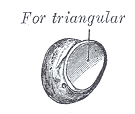Pisiform bone
| Pisiform bone | |
|---|---|
_01_palmar_view.png) Left hand anterior view (palmar view). Pisiform bone shown in red. | |
 The left pisiform bone | |
| Details | |
| Origins | ulnar collateral ligament |
| Articulations | triangular |
| Identifiers | |
| Latin | Os pisiforme |
| MeSH | A02.835.232.087.319.150.600 |
| TA | A02.4.08.007 |
| FMA | 23718 |
The pisiform bone (/ˈpaɪsᵻfɔːrm/ or /ˈpɪzᵻfɔːrm/), also spelled pisiforme (from the Latin pisifomis, pea-shaped), is a small knobbly, pea-shaped bone that is found in the wrist. It forms the ulnar border of the carpal tunnel.
Structure
The pisiform bone is a small bone found in the proximal row of the wrist (carpus). It is situated where the ulna joins the wrist, within the tendon of the flexor carpi ulnaris muscle.[1]:199,205
It only has one side that acts as a joint, articulating with the triquetral bone. It is on a plane anterior to the other carpal bones and is spheroidal in form.
The pisiform bone has four surfaces:
- The dorsal surface is smooth and oval, and articulates with the triquetral: this facet approaches the superior, but not the inferior border of the bone.
- The palmar surface is rounded and rough, and gives attachment to the transverse carpal ligament, the flexor carpi ulnaris and the abductor digiti quinti.
- The lateral and medial surfaces are also rough, the former being concave, the latter usually convex.
Function
Unlike the other carpal bones, the pisiform is not involved in movement of the wrist.[2] :5
Etymology
The etymology derives from the Latin pīsum which means "pea".
Other animals
As compared with apes, which have an elongated Pisiform, humans have a shorter pisiform bone. This is due to the loss of the single growth plate typically found in other mammalian pisiforms.[3] This may be because of evolutionary benefits from having a shorter pisiform bone, including facilitating ulnar deviation of the hand, and preventing hyperextension of the wrist, actions that improve the action of clubbing.[4]
See also
| Wikimedia Commons has media related to Pisiform bone. |
Additional images
_-_animation01.gif) Position of pisiform bone (shown in red). Left hand. Animation.
Position of pisiform bone (shown in red). Left hand. Animation._-_animation02.gif) Pisiform bone of the left hand. Close up. Animation.
Pisiform bone of the left hand. Close up. Animation._-_animation03.gif) Pisiform bone (red) forms ulnar border of the carpal tunnel. Left hand. Animation.
Pisiform bone (red) forms ulnar border of the carpal tunnel. Left hand. Animation. Pisiform bone.
Pisiform bone.
References
- ↑ Tim D. White, Human Osteology, 2nd edition (San Diego: Academic Press, 2000)
- ↑ Beasley's Surgery of the Hand. Thieme New York. 2003. ISBN 9781282950023.
- ↑ Kjosness, Kelsey M.; Hines, Jasmine E.; Lovejoy, C. Owen; Reno, Philip L. (November 2014). "The pisiform growth plate is lost in humans and supports a role for in growth plate formation". Journal of Anatomy. 225 (5): 527–538. doi:10.1111/joa.12235.
- ↑ Young, Richard W. (January 2003). "Evolution of the human hand: the role of throwing and clubbing". Journal of Anatomy. 202 (1): 165–174. doi:10.1046/j.1469-7580.2003.00144.x. PMC 1571064
 . PMID 12587931.
. PMID 12587931.
External links
- Cross section image: limbs/hand/hand-fr-1 - Plastination Laboratory at the Medical University of Vienna
- Hand kinesiology at the University of Kansas Medical Center
- Illustration at ntu.edu.tw